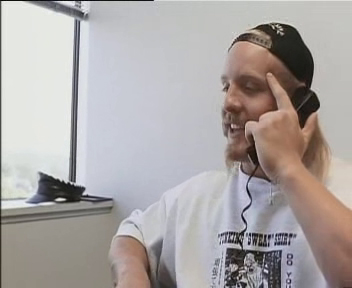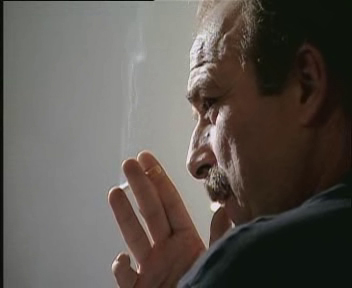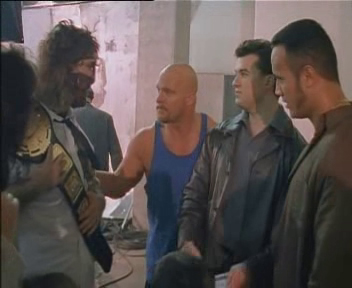Review: Beyond The Mat
An awful lot has changed in the world over the last 21 years.
Back in 1999, Bill Clinton was President of the USA, Tony Blair was Prime Minister of the UK, Star Wars Episode I: The Phantom Menace had just been released on the world and a little known piece of software called Napster brought the file sharing of music and videos to the masses – masses that were still using Internet Explorer 5.
Stone Cold Steve Austin was rated number one in the Pro Wrestling Illustrated 500, both Adam Cole and Bayley turned 10, Liv Morgan was just five years old… and Xia Brookside had only just been born. Tragically, it was also the year that Rick Rude and Gorilla Monsoon passed away, and Owen Hart fell to his death.
Alongside these highs and painful lows, 1999 also marked the release of Barry Blaustein’s seminal wrestling documentary Beyond the Mat – which arrives on Netflix today. In it, the film-maker explored his own love of wrestling by peeping behind the curtain to find out more about this previously quite hidden world.

By chance or by design, he captured some truly important moments in wrestling – moments which had long lasting ramifications for wrestlers, for promotions and for the industry as a whole – which we otherwise wouldn’t have seen. During the more than three years he spent gathering footage, Blaustein recorded Darren Drozdov’s signing with the WWF – a decision that would ultimately leave Droz paralysed after a tragic accident in the ring, Paul Heyman delivering a locker room pep talk to the ECW roster ahead of their first ever Pay Per View, Mick Foley deciding that maybe he shouldn’t be the guy that takes crazy bumps anymore and Terry Funk retiring… albeit temporarily.
Oh, and we saw New Jack doing a try-out for a talent agency. “I think he’s got a great face. I think he’s got sexuality, charm…” comments the scout – who may or may not have been aware of the four justifiable homicides that New Jack had on his record at the time.
You have all made it to the dance.
Paul Heyman: Beyond the Mat
With no WWE Network providing behind the scenes documentaries, the mainstream press barely mentioning wrestling unless it was to report a death or steroid scandal and with wrestling magazines remaining the main source of insider news, Beyond the Mat was revolutionary for wrestling fans. We got to explore Titan Tower. We sat at the Gorilla Position for the first time. We followed Mick Foley backstage and ultimately into his home where he would watch back a particularly brutal Royal Rumble “I Quit” match alongside his wife. We saw a young Joey Styles doing a piece to camera in a New York suburban home basement, while Paul Heyman’s mother does her laundry safely out of shot and the mastermind of ECW leans on the ironing board, watching it all happen.
It was all so new. Now, more than 20 years on, it’s obviously become much more of a historical document – a snapshot of a time that some of us can look back on, while other younger audiences can experience for the first time. Yet however you come at Beyond the Mat, and whether or not the times and people depicted within it are familiar or brand new to you, one thing remains true: the real beauty of this documentary is how it somehow manages to deftly switch between an industry wide overview of all aspects of the wrestling landscape – from bingo hall indies through to the WWF and all points in between – but still manages to tell intimate and personal stories too.
We heard stories like the ambitions of rookie wrestler Mike Modest, hoping to break out from performing in front of crowds of 100 to landing a WWF contract. It’s a tale that still resonates with rookie wrestlers today – admittedly, the name of the goal might now be World Wrestling Entertainment rather than the World Wrestling Federation, but it’s the same target – and still with the same Vince at the helm.
Maybe I will be the guy who pulls the sock of his tights for the next couple of years.
Mick Foley: Beyond the Mat
We bear witness to Mick Foley reassessing his entire career, and beginning a transition from being a hardcore legend to a legend that doesn’t take so many unprotected chair shots to the head anymore. This story could be arguably playing out again right now thanks to Matt Hardy and his very public close calls in recent AEW matches – it’s all unnervingly familiar.
Sadly, stories like the one of Jake ‘The Snake’ Roberts, deep in the midst of a battle with numerous addictions including sex, drugs and alcohol, have also played out countless times since then in the wrestling world. In all of these cases, from the rookie, to the risk-taker, to the addict, the stories repeat – but only the names change.

Of course, with the benefit of hindsight and 21 years of time between this movie being made and today, we can now say exactly how some of those stories played out.
Thankfully, Jake Roberts continues to win in his ongoing battle with addiction, most recently finding himself as the venomous mouthpiece of Lance Archer in AEW. We know that Droz’s career was cut painfully short after his planned pairing with the Legion of Doom. We’re aware that Mike Modest’s tryout with the WWF didn’t lead to a contract with the Stamford company, but he did go on to appear in WCW, Pro Wrestling Noah and Stampede Wrestling, as well as running Pro Wrestling IRON – his own promotion. Indeed, it’s lovely to hear him say: “Japan would be the place for me to go,” safe in the knowledge that he did indeed make it there.
This distance also answers what lay in the future of Modest’s tryout partner Tony Jones, who did go on to make a number of appearances for the WWE working as an enhancement talent, even making it to TV on episodes of WWE Heat, before ultimately spending the majority of his wrestling career in APW.
Sometimes I realise the person I hate most in this life is the person I’m looking at in the mirror.
Jake Roberts: Beyond the Mat
Of course, over a long enough expanse of time, the survival rate of any project like this will hit zero, and that’s the case with Beyond the Mat too. The man that took both Modest and Jones to their WWF tryout, accountant turned promoter Roland Alexander, died at the age of 59. You wonder if he could have predicted that his promotion and training school would live on to such a degree that it’s now fast approaching a 30th anniversary milestone.
Dennis Stamp, the former wrestler turned pest exterminator that was looking for one more match to put an exclamation point on his career did end up getting exactly that, wrestling for the final time in AIW in 2015, before passing away two years later.
Both Joanie “Chyna” Laurer and Luna Vachon, who featured briefly in the documentary, have also passed away in the years since the documentary was made. It’s a sobering watch at times, seeing so many of these ambitious young men and women, some being interviewed, others just passing by in the background of a shot but on the cusp of stardom who, for a variety of reasons, are no longer with us.
Thankfully, the three main figures that Blaustein choses to follow – Mick Foley, Terry Funk and Jake Roberts – are still very much with us. It’s through their experiences, the stages they were in their careers at the time, and the transitions that each one of them was going through where the real heart of the story can be found.
Foley, riding high on his reputation for extreme bumps, a seemingly unstoppable ability to absorb punishment and just a little bit of fanboy-made-good charm, would be stopped in his tracks by documentary footage of a young Noelle Foley weeping as she watches her dad take chairshot after chairshot to the head during a particularly brutal Royal Rumble match with the Rock.
Terry Funk would explore his feelings over hanging up his boots, and marking the end of a memorable 35+ year career, still giving his all to the sport that he loves. The subtext is clear: if he doesn’t do this, wonders Funk, what the hell will he do?
Roberts, meanwhile, would be painfully open and honest about his relationships with his family, with drugs and with sex, simultaneously allowing the cameras to follow him as he attempts a reconciliation with his estranged daughter. Knowing that he makes it out the other side in no way reduces how uncomfortable it is to watch the man who delivered icy cold and eloquent promos in the ring to struggle with simply getting through each day.
It remains a fascinating watch, not least because it’s so telling to see how cyclical the wrestling business appears to be. Promotions rise and fall. Wrestlers come and go. Some stay too long, risk too much, and push their bodies further than they should. Others step away but never lose the love for the roar of a crowd. Some lose everything – their life included – in the pursuit of their dreams, or in the fallout of the lifestyle they follow as a result of making it. As philosopher George Santayana once wrote, those who fail to learn from history are doomed to repeat it – and far too many of the stars we’ve loved have done just that.
It’s not been immune to criticism, though. Speaking on Wrestlezone Radio, Jake Roberts said: “(Beyond the Mat) was a bunch of BS. It was a rip off. I never got a nickel out of that. They lied to me. They lied to my family and then they painted us all in a bad way.”
Jim Cornette, who briefly appears in the early stages of the doc was also uncomfortable with how Beyond the Mat took viewer behind the curtain to a previously secretive world. Speaking in 2014, he said: “I didn’t wanna be involved in that fucking movie because I knew they were going to show backstage shit. Remember, this was just edge of the internet. There was still a lot of shit that had never been shown, never been talked about, a lot of people didn’t know.
“I didn’t expose anything there… but everyone else was working hard to do so.” Whatever your take and even against the backdrop of this criticism, it’s a compelling watch.

“What kind of person does this for a living?”, Blaustein asks near the end of his film. “They’re showman. They’re Carnies. They’re fathers. They’re sons. They’re artists. They are toys. They are people, with families, with the same concerns and fears we all share. They’re just like you and me… except they’re really different.” They were then. They remain so now.
Ultimately, Beyond the Mat is a documentary that genuinely does live up to the title: we really are taken from our ringside seat to a formerly off-limits world. We do follow these wrestling icons through the curtain. We see the toll that their lives can take, and witness the highs and lows that come with that life. It’s a rare and privileged journey to go on, and one that every wrestling fan should sample at least once. Sure, it’s 21 years old. No, it’s not shot in widescreen, and OK, the transfer isn’t in HD. Yet none of that really matters. For the stories it tells, for the history it captures, and for the peep behind the curtain it offered to wrestling fans, Beyond the Mat remains what it was back in 1999: absolutely essential viewing.
Beyond the May is available on Netflix from Thursday 1st October 2020.
